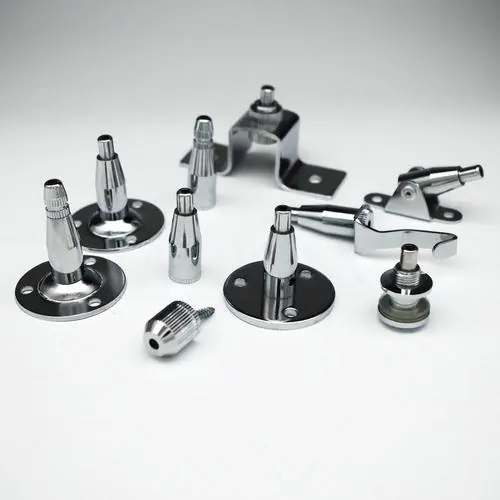Introduction to Chromium Plating
As a key component of stainless steel alloys, chromium imparts corrosion resistance and hardness. Chromium also shines through chrome plating – electrolytically depositing ultrathin metallic chromium onto substrates. This surface engineering technique decorates objects aesthetically with chrome's lustrous finish. More critically, it fortifies them against corrosion and wear. Precisely controlling chromium layer thickness from 0.001 inches, plating creates durable protective coatings. Further tailoring through chromium alloying produces optimized anti-corrosion, anti-abrasion surfaces for applications from automotive parts to industrial equipment.
ChromiumPlating and itsWorkingPrinciple
Chrome plating electrochemically deposits an ultra-thin chromium layer onto metal surfaces, producing an attractive chrome finish. Beyond aesthetics, this microscopic chromium coating significantly enhances corrosion resistance, cleanability, and surface hardness. By precisely controlling chromium deposition thickness, components can be optimized for wear-resistance, friction reduction, and other functional performance gains through surface engineering. Chrome plating thereby transforms base materials with multifunctional metallic skins.
Chrome plating relies on electrodeposition from metal salt electrolytes to coat objects flawlessly. The target substrate is immersed in a chrome plating bath containing chromium cations. As these ions reduce at the surface, a uniform metallic chromium layer deposits through this electrochemical reaction, smoothly covering the underlying form.
Pre-treating substrates proves critical prior to chrome plating. Degreasing eliminates thick contaminants before manual cleaning scrubs away remaining surface impurities. Pretreatment methods then diverge based on the substrate metal. Different etching solutions like hydrochloric, sulfuric or hydrofluoric acids target specific alloys - ferric chloride commonly etches Nimonics. Electrifying components during vat immersion further enhances plating distribution. By tailoring multi-step pretreatments to each base metal, substrates undergo optimization for uniform, flawless chrome coatings.
During plating, electrical current regulates chromium deposition rate and thickness. Higher currents rapidly coat objects while lower intensities provide slower, more controlled plating. Optimal plating durations are predetermined based on the desired thickness and application. By tuning the current, chrome layers can be efficiently engineered to specification across diverse components and use cases.
The Ins and Outs of Chrome Plating: Key Procedural Steps
Hexavalent Chromium Plating
While extremely hazardous and carcinogenic, hexavalent chromium remains the dominant functional chrome plating chemistry. However, managing this technique's toxic bath waste as regulated hazardous material proves challenging.
Trivalent Chromium Plating
Trivalent chromium plating utilizes safer chromium sulfate or chloride compounds. By adopting this green alternative, certain applications can replace hexavalent chromium to reach equivalent coating thicknesses. Nevertheless, trivalent chromium usage and disposal still require careful regulation given environmental concerns.
In summary, as an eco-friendly yet controlled alternative, trivalent chromium is gaining traction to supplant high-risk hexavalent plating in suitable contexts. Still, hexavalent approaches persist for now to meet the most demanding performance specifications.

Applications
Boasting durability and corrosion protection along with eye-catching brilliance, the automotive industry chrome plates components like wheels, engine parts and exhausts for performance and style. Decorative chrome also graces kitchenware, premium tools and tapware, elevating their aesthetic appeal. Alternatively, hard chrome functionally fortifies ferrous and nonferrous engineering components against wear and friction, from stainless steel alloys to brass. With this versatility, chromium platings decorate and safeguard both consumer and industrial applications through tailored surface enhancement.
Chromium Sputtering Target
True to its Greek chroma roots meaning color, chromium lends eye-catching brilliance through decorative plating. By electrolytically depositing ultra-thin, glossy chromium films, everyday items gain stylishly corrosion-resistant metallic finishes. Particularly for aesthetically driven applications, chromium sputtering targets also enable precision material deposition. Magnetron sputtering chromium produces glamorous coatings for watches, electronics, appliances, and more. Whether by plating or sputtering, chromium’s vibrant hues enhance visual appeal across consumer products when a touch of glitz is desired.
Boasting a high melting point, dense composition, and lustrous finish immune to tarnishing, metallic chromium possesses inherent corrosion resistance. Upon air exposure, chromium rapidly forms a microscopically thin yet impenetrable oxide layer that shields the reactive surface. This tough, passive film makes chromium extraordinarily hardy and impervious to further oxidation. When alloyed into stainless steel, chromium imparts the same protective qualities that resist discoloration and withstand harsh conditions. The addition of only a small amount of chromium metal during steel production transforms the material into a far superior corrosion-resistant alloy. This breakthrough discovery of stainless steel ushered in a new era of durable, long-lasting metallic materials. Chromium’s superficial oxide coating thus makes it an ideal engineering addition for boosting longevity across critical applications.
Conclusion
Despite utilizing hazardous chemicals requiring regulated disposal, chrome plating persists as a cost-effective alternative to nickel plating. By optimizing chemical management, chrome plating safely realizes functional benefits like wear resistance at lower expense.
